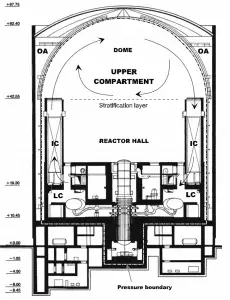Ice Condenser Containment Building
Containment buildings and containment pressure-suppression systems vary widely depending on certain reactor designs. In some cases, unique technologies can be installed. For example, the containment building of Loviisa NPP uses two ice condensers as the pressure-suppression system.
The ice condenser is a safety system designed to rapidly absorb steam and reduce containment pressure following a Loss of Coolant Accident (LOCA) or Main Steam Line Break (MSLB). The high-pressure steam following LOCA or MSLB conditions is directed into chambers containing baskets filled with ice. Ice blocks, being naturally cooler than the steam, will remove heat from the steam, which will cause the steam to condense. This will cause a reduction in the pressure of the building and will also reduce the temperature of the containment atmosphere.
This system has many positive features. Pressure suppression via ice condensers is very effective because of the ability of ice to absorb a high amount of energy during a phase transition. This feature allows containment buildings to be much smaller than conventional containment buildings. Moreover, water from ice melting can be used for passive cooling and flooding of the small-sized cavity (in the case of Loviisa NPP), where the reactor is located.
Ice condenser containments were designed by Westinghouse in the late 1970s and early 1980s, therefore in the United States there are 9 ice condenser containments on 5 sites. Except Loviisa NPP there is one other ice condenser unit in the world, the Ohi plant in Japan.
